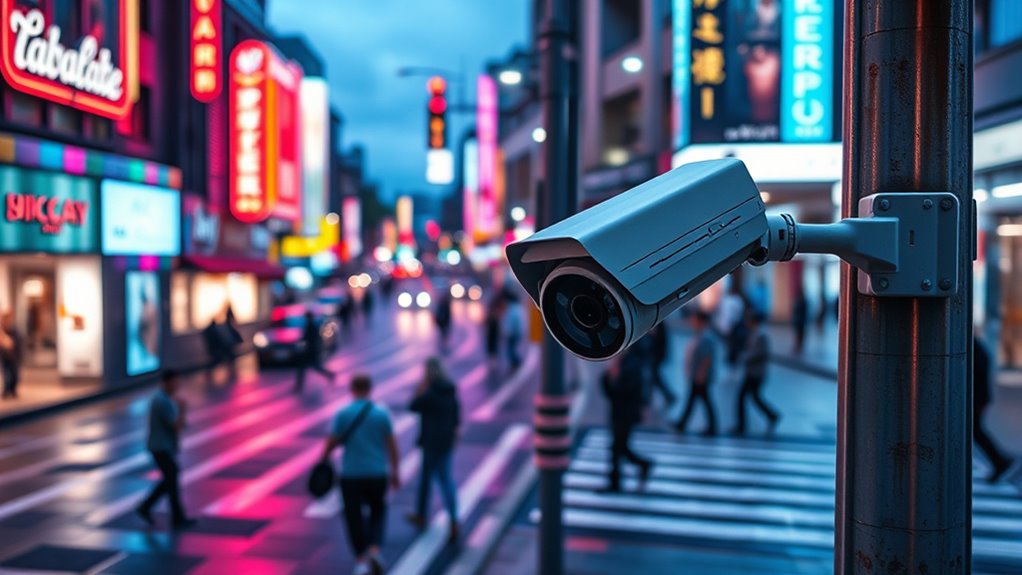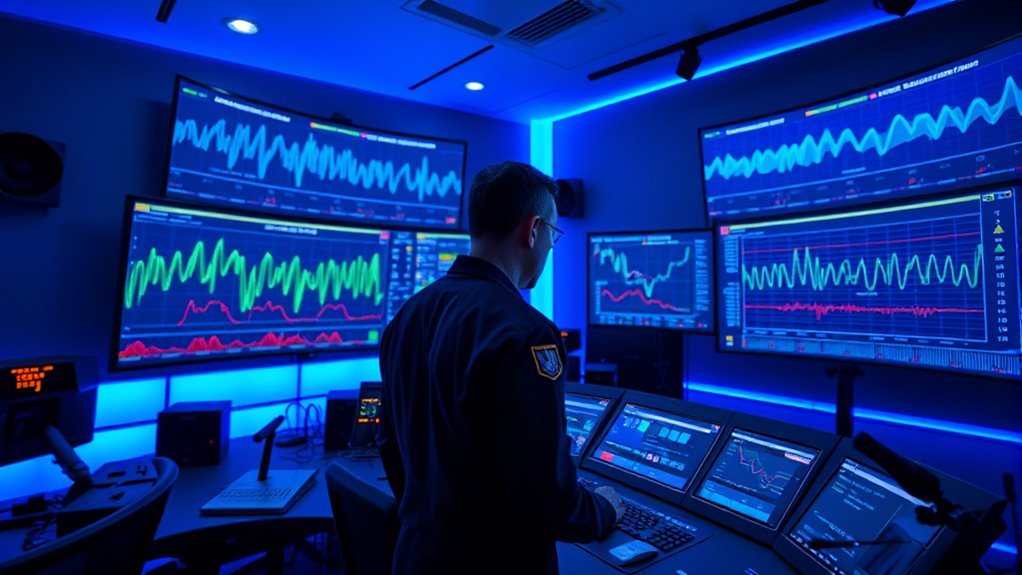Automatic sound event detection helps you stay safe by alerting you instantly to critical sounds like alarms, glass breaking, or cries for help. It uses machine learning to analyze audio patterns in real-time, so you can respond quickly to emergencies. This technology continuously improves accuracy by learning from new data and reduces false alarms. If you’re interested, you’ll discover how it integrates seamlessly into safety systems to protect environments like schools, factories, and transit stations.
Key Takeaways
- Utilizes machine learning algorithms to identify critical safety sounds like alarms, gunshots, or glass breaking in real-time.
- Continuously trains on acoustic data to improve detection accuracy and reduce false alarms.
- Provides immediate alerts to security systems or personnel, enabling rapid response to emergencies.
- Adapts to evolving environments by refining sound recognition capabilities through ongoing data collection.
- Enhances safety infrastructure by integrating automated detection with other safety protocols and alert systems.

Automatic sound event detection is transforming safety systems by enabling real-time identification of critical auditory signals. When you rely on these advanced systems, you tap into the power of machine learning and acoustic analysis to recognize sounds that could indicate danger or emergencies. This technology processes audio data continuously, quickly distinguishing between normal background noise and unusual sounds that demand immediate attention. Whether it’s a siren, glass breaking, or a cry for help, the system can alert you instantly, reducing response times and increasing safety.
Real-time sound detection enhances safety by instantly identifying critical auditory signals and triggering swift alerts.
At the core of this innovation is machine learning, which trains algorithms to recognize patterns within audio signals. You don’t have to program every specific sound; instead, the system learns from vast amounts of acoustic data, becoming increasingly accurate over time. This adaptability means it can identify a wide range of sounds across different environments, whether in a busy factory, a school, or a public transit station. The acoustic analysis component plays a *significant* role here, breaking down sound waves into meaningful features. It examines frequency, amplitude, and temporal patterns to differentiate between sounds that may seem similar to the human ear but require precise analysis for automatic detection.
You’ll find that these systems are incredibly responsive because they operate in real-time. As soon as a suspicious sound is detected, the system can trigger alarms, alert security personnel, or even activate other safety protocols. This immediate response capability is especially *essential* in situations where every second counts, such as detecting a fire alarm or a gunshot in a public space. The combination of machine learning and acoustic analysis enables these systems to adapt to new sounds or changing environments without losing accuracy, making them reliable tools in diverse safety applications.
Moreover, you benefit from continuous improvement as the system gathers more data. With ongoing training, it refines its sound recognition capabilities, reducing false alarms and increasing detection precision. This feedback loop ensures that safety measures stay current with evolving sound patterns in different settings. By integrating automatic sound event detection into safety infrastructure, you’re empowering your environment with smarter, more responsive alert systems. You get a proactive layer of security that not only detects threats faster but also minimizes disruptions caused by false alarms, creating safer spaces for everyone. Additionally, the ongoing development of educational toys that promote sensory skills can complement safety initiatives by supporting children’s development in engaging ways.
Frequently Asked Questions
How Does Sound Event Detection Adapt to Different Environments?
You can enhance sound event detection by focusing on environmental adaptation and contextual awareness. By training your system with diverse data from various environments, it learns to recognize sounds accurately regardless of background noise. Implementing adaptive algorithms allows your system to adjust parameters dynamically, improving performance in different settings. This way, it becomes more reliable, effectively distinguishing relevant sounds even amid changing environmental conditions.
What Are the Limitations of Current Sound Detection Technologies?
Think of sound detection tech as a keen-eyed guard, but even the best guard faces blind spots. You’ll find that audio quality can be compromised by poor microphones or recording conditions, and ambient noise often masks important sounds, making detection tricky. These limitations mean false alarms or missed events happen more often, reducing reliability. Until technology advances, you might still need human oversight to guarantee safety isn’t compromised.
How Is Privacy Maintained With Continuous Audio Monitoring?
You maintain privacy during continuous audio monitoring by focusing on detecting specific sound events amid ambient noise, rather than recording entire conversations. Data encryption secures the audio data, preventing unauthorized access. Additionally, many systems process sounds locally, minimizing data transmission. These measures guarantee that your privacy stays protected, even as safety technologies monitor for critical sounds, allowing for effective response without compromising your personal information.
Can These Systems Distinguish Between Similar Sound Events?
Imagine you’re walking through a busy street, where sounds overlap like a tangled web. These systems can often tell similar sound events apart, but false positives and sound overlap can challenge their accuracy. They analyze subtle differences in sound patterns, helping distinguish between a dog barking and a siren. While not perfect, advanced algorithms improve their ability to differentiate, reducing false alarms and ensuring reliable safety detection in noisy environments.
What Are the Future Developments in Automatic Sound Detection?
You’ll see future developments in automatic sound detection focus on integrating edge computing and advanced deep learning techniques. These innovations will enable real-time, accurate detection directly on devices, reducing latency and improving safety. Expect smarter algorithms that adapt to new sound environments, enhanced hardware for better processing, and more energy-efficient systems. Together, these advancements will make sound event detection more reliable and accessible for safety applications across various settings.
Conclusion
By harnessing automatic sound event detection, you could revolutionize safety like never before—imagine a world where every dangerous sound is caught instantly, preventing accidents before they happen. Your environment becomes an impenetrable fortress of alertness, saving countless lives and millions in damages. This technology isn’t just a tool; it’s your ultimate safety superhero, working tirelessly 24/7. Get ready to witness the future where safety isn’t just a goal, but an unstoppable, sound-powered force of nature!










